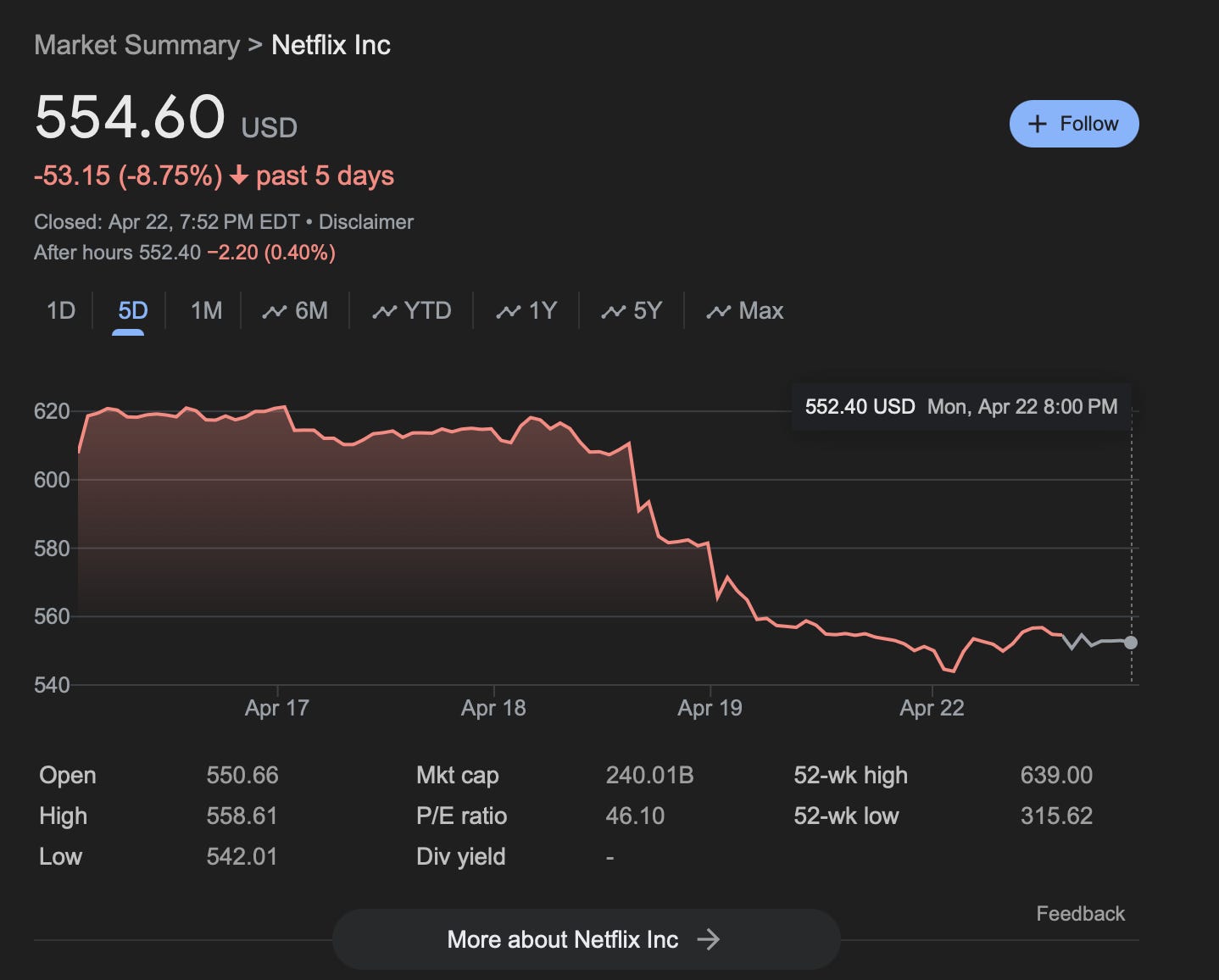💡📸 🎬 $NFLX Analysis Now Showing 💥
🎬Prologue
On 4/18/2024, Netflix reported Q1 FY2024 earnings and its price dropped almost 10%. As its happened many times before, the market may have over reacted to what the company disclosed.
On this episode of The Dividend Journal, we’re going to be:
→ Looking at the key takeaways from $NFLX’s Q1 report
→ Project what the future holds for the company
🎬 Act 1 : Q1 Takeaways
I think it’s appropriate to first address what every headline is focusing on in regards to $NFLX’s Q1 report. They will no longer report paid memberships!
Super dramatic, let’s not freak out. Here’s the fine print: They won’t report their subscriber numbers starting next year and they will only stop reporting subscriber numbers so frequently.
Isn’t this basically Netflix saying their subscriber numbers will go down?
While possible, that’s not necessarily true. It’s more complicated than a yes or no answer. The company is rolling out a cheaper, advertising included subscription option into the fray. By including the subscribers from this cheaper option, it would jumble the subscriber numbers and wouldn’t really paint a clear picture on the performance of the company.
“The streaming company is navigating its transformation from targeting subscriber growth to focusing on profit.” They are still going to report subscriber milestones, it’s not the end of the world! 😌
How would subscriber counts now muddy the water on performance?
At Netflix’s IPO in 2002 and while the company grew, subscriber count was a phenomenal metric as a way to gauge how well they were doing. They were a media disruptor at the time. Media on demand and not going to a theatre or wait for Friday to watch the next episode of your favorite show was a completely alien concept. Netflix didn’t have revenue or profits to report. So, the more subscribers = more growth for the company. This was the perfect way to determine the demand for Netflix’s product.
However, after generating $9.37 billion in Q1 of FY2024, Netflix is clearly no longer a media disruptor and is instead the market leader. It makes sense that the company is now pushing to be evaluated based on other more mature metrics. Plus, advertising support subscription options as well as plans to roll out live events means that subscriptions are not the sole component to the growth of the company anymore.
Okay, fine. What other metrics then?
For one, Netflix’s operating margin rose to 28% in the first quarter of their fiscal year 2024. A 7% increase from Q1 of FY2023, and 28% being the highest ever for the company.
Despite the dip in operating margin in Q4 FY 2022, Netflix has steadily been improving their profitability quarter to quarter. This is a tell tale sign that the company has figured out how to manage rolling out original content and keeping costs manageable.
Moreover, Netflix’s free cash flow (FCF) has consistently been increasing every quarter. A higher FCF has traditionally always been a signal that a company is efficiently running its business and has more room to grow. FCF measures the amount of cash generated that is available to pay off debt obligations, make acquisitions, and investments. Netflix now has $2.1B in FCF as of Q1 FY 2024, which is a 51% increase from the previous quarter.
It’s important to note that Netflix’s FCF has been pretty turbulent for the past two years. It’s still a little too early to use FCF too heavily as a metric to judge Netflix’s performance.
🎬 Act 2 : What the future holds
Netflix raised its operating margin projections up to 25% for Q2 despite stating that there will be less subscribers based on seasonality. On the other hand, Netflix projects Q2 revenue growth to be 16% while having FY 2024 revenue growth to be between 13% to 16%. This indicates that Netflix is clearly expecting dips in pace of growth in the second half of the year.
I believe Netflix needs to continue to perform well quarter by quarter, and prove to the market that these other metrics like operating margin and revenue growth are their new bread and butter. Without subscriber count under the microscope, investors will be scrutinizing other parts of the business model. Netflix will need to make sure they are able to back up their confident statements of being a mature company with the numbers.
As Netflix begins to roll out new features like ad-supported subscription options and live content viewing, it will be interesting to see how they tackle the hurdles that these new parts of the business will bring. To stay at the top, you must adapt and constantly evolve to keep up with the competition. Netflix will have to do this if they want to remain the market leader.




